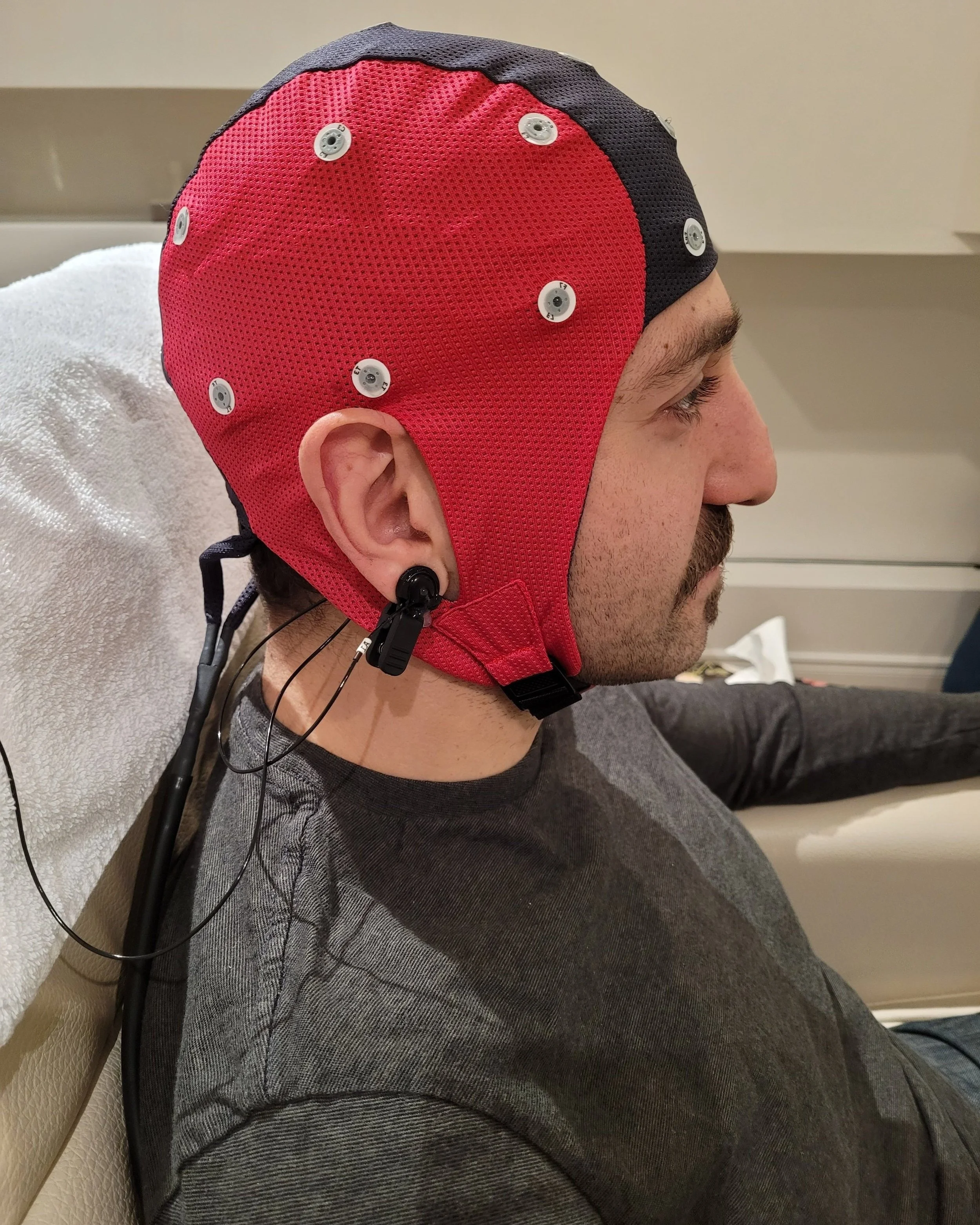
Neurotherapy
Assists the brain in becoming more balanced and fluid by breaking up the patterns of intrusive symptoms, and encouraging healthier pathways to be established.
NEUROFEEDBACK
Neurofeedback is a process of measuring the brain’s electrical activity, and then feeding back that information to the brain so that it can learn about its own function.
This is done while the brain is being tasked in a particular way, so that the brain may optimize itself toward the performance of that task.
Neurofeedback capitalizes on the brains capacity for neuroplasticity.
The goal of neurofeedback, is to train the brain toward greater flexibility and resiliency, and away from stuck patterns that limit functionality
How is Neurofeedback performed?
The Neurofeedback trainee sits in a comfortable reclining chair with sensors attached to the scalp and ears.
The sensors measure the brains electrical activity and record it through a computer program.
The trainee watches images on a computer screen while music is played through headphones.
The brains performance is played back to itself, and with the help of the program, the brain is shown when it is forming optimal patterns of self-regulation, and when it is hitting a pattern, or stuckness.
As the brain begins to adapt itself to accomplishing the task, healthy patterns are exercised, excessive patterns are recalibrated, and new neural pathways are generated that improve the brain’s efficiency
VAGUS NERVE STIMULATION with NEUROFEEDBACK
The Vagus Nerve is the longest and most complex of the cranial nerves and runs from the brainstem through the face and thorax to the abdomen. It is a mixed nerve that contains parasympathetic fibres and contributes to many functions of the body including regulation of internal organ functions, such as digestion, heart rate, and respiratory rate, as well as vasomotor activity (dilation and constriction of blood vessels), and certain reflex actions, such as coughing, sneezing, swallowing, and vomiting
After trauma or long term stress, the Sympathetic Nervous System (SNS) can remain fully in the ‘on’ position, even though the danger may be past. When this occurs, the Parasympathetic Nervous System (PNS) is also disrupted and unable to effectively mitigate the stress responses that are activated by the SNS.
At WellSpace, we help increase vagal tone through Pulsed Electromagnetic Field stimulation (PEMF) that is absorbed into the vagus nerve, supporting it to down-regulate Sympathetic Nervous System arousal, and increase vagal tone. When Neurofeedback training is paired simultaneously with Vagus Nerve Stimulation, the training helps to reinforce the slowing, calming effect of the PEMF within the brain. In this way, the brain learns how to hold the capacity for slowing the system down, and begins to function in a more regulated way. The client feels this in their own Central Nervous System as less anxiety and tension, more psychological, physical and emotional ease, and greater resilience to stress.
Wellspace Toronto Vagus Nerve Stimulation with NEUROFEEDBACK
Symptoms Affected are:
Anxiety and Panic
Rumination
Hypervigilance
Physical and Psychological Tension
Improvement Noted in:
Sleep
Focus
Mood
Energy
NEUROSTIMULATION
Neurostimulation introduces specific information to the brain about what it needs to regulate itself.
When networks in the brain cannot communicate effectively, the brain may need specific information about how to do things differently. Neurostimulation methods deliver that information to the brain with frequencies that are introduced through gentle electrical energy pulses. As these frequencies speak to your brain in the electrical language it understands, your brain is shown how to communicate more effectively with itself. As information flows more freely between networks, the brain learns how to regulate itself, and the learning is permanent. Several methods of Neurostimulation are available at WellSpace Trauma Therapy Clinic.
Types of Neurostimulation
Pulsed Electro-Magnetic Field Stimulation (PEMF): This technology delivers very gentle electromagnetic fields transcranially (through the skull) or through the body. It is a painless and effective way of providing the brain with the information it needs to make more of the frequencies in which it is deficient.
Transcranial Alternating Current Stimulation (TACS): This technology delivers gentle frequency-based current transcranially or through the body.
Transcranial Direct Current Stimulation (TDCS): This technology works to deliver gentle levels of direct current to enhance neuroplasticity, foster greater connectivity and break up stuck patterns in the brain.
Transcranial Random Noise Stimulation (TRNS): This technology delivers a ‘white noise’ effect to the brain, offering multiple frequencies at once so the brain is able to take what it needs. It assists in calming frequencies that are in excess, and in moving the brain out of stuck patterns so it can function in a more balanced and regulated manner.
A QEEG (quantitative electroencephalogram) or ‘Brain Map’ is a non-invasive process that is solely for the purposes of generating images and data
QUANTITATIVE ELECTROENCEPHALOGRAM
A QEEG is not a treatment, but the information gathered from the QEEG can help assist us in determining a course of neurotherapy. The procedure involves being hooked up to a multi-channel system that records the electrical activity in the brain’s resting state networks. It reveals how the brain is disseminating the electrical activity available, where connectivity issues may exist, and what frequencies are in excess or in deficiency. The state of our brains balance of available energy contributes greatly to how we feel, and the ease with which we may transition through states of sleep, wakefulness, focus, relaxation, excitement, calm, etc.




